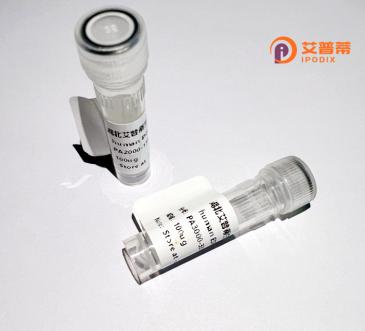
| 纯度 | >90%SDS-PAGE. |
| 种属 | Human |
| 靶点 | RBBP8 |
| Uniprot No | Q99708 |
| 内毒素 | < 0.01EU/μg |
| 表达宿主 | E.coli |
| 表达区间 | 1-897 aa |
| 活性数据 | MNISGSSCGSPNSADTSSDFKDLWTKLKECHDREVQGLQVKVTKLKQERILDAQRLEEFFTKNQQLREQQKVLHETIKVLEDRLRAGLCDRCAVTEEHMRKKQQEFENIRQQNLKLITELMNERNTLQEENKKLSEQLQQKIENDQQHQAAELECEEDVIPDSPITAFSFSGVNRLRRKENPHVRYIEQTHTKLEHSVCANEMRKVSKSSTHPQHNPNENEILVADTYDQSQSPMAKAHGTSSYTPDKSSFNLATVVAETLGLGVQEESETQGPMSPLGDELYHCLEGNHKKQPFEESTRNTEDSLRFSDSTSKTPPQEELPTRVSSPVFGATSSIKSGLDLNTSLSPSLLQPGKKKHLKTLPFSNTCISRLEKTRSKSEDSALFTHHSLGSEVNKIIIQSSNKQILINKNISESLGEQNRTEYGKDSNTDKHLEPLKSLGGRTSKRKKTEEESEHEVSCPQASFDKENAFPFPMDNQFSMNGDCVMDKPLDLSDRFSAIQRQEKSQGSETSKNKFRQVTLYEALKTIPKGFSSSRKASDGNCTLPKDSPGEPCSQECIILQPLNKCSPDNKPSLQIKEENAVFKIPLRPRESLETENVLDDIKSAGSHEPIKIQTRSDHGGCELASVLQLNPCRTGKIKSLQNNQDVSFENIQWSIDPGADLSQYKMDVTVIDTKDGSQSKLGGETVDMDCTLVSETVLLKMKKQEQKGEKSSNEERKMNDSLEDMFDRTTHEEYESCLADSFSQAADEEEELSTATKKLHTHGDKQDKVKQKAFVEPYFKGDERETSLQNFPHIEVVRKKEERRKLLGHTCKECEIYYADMPAEEREKKLASCSRHRFRYIPPNTPENFWEVGFPSTQTCMERGYIKEDLDPCPRPKRRQPYNAIFSPKGKEQKT |
| 分子量 | 128.3 kDa |
| 蛋白标签 | GST-tag at N-terminal |
| 缓冲液 | PBS, pH7.4, containing 0.01% SKL, 1mM DTT, 5% Trehalose and Proclin300. |
| 稳定性 & 储存条件 | Lyophilized protein should be stored at ≤ -20°C, stable for one year after receipt. Reconstituted protein solution can be stored at 2-8°C for 2-7 days. Aliquots of reconstituted samples are stable at ≤ -20°C for 3 months. |
| 复溶 | Always centrifuge tubes before opening.Do not mix by vortex or pipetting. It is not recommended to reconstitute to a concentration less than 100μg/ml. Dissolve the lyophilized protein in distilled water. Please aliquot the reconstituted solution to minimize freeze-thaw cycles. |
以下是关于重组人RBBP8(CtIP)蛋白的3篇代表性文献及简要摘要:
---
1. **文献名称**: "Human CtIP promotes DNA end resection"
**作者**: Sartori, A.A. et al.
**摘要** (2007. Nature):
该研究首次揭示了RBBP8(CtIP)在DNA双链断裂修复中的核心作用,通过与BRCA1相互作用促进DNA末端的切除(end resection),激活同源重组修复(HR)通路,并调控细胞对放射线的敏感性。
---
2. **文献名称**: "CtIP protein dimerization is critical for its recruitment to DNA damage sites"
**作者**: Qiao, H. et al.
**摘要** (2021. Nature Communications):
通过结构生物学和功能实验,阐明了RBBP8的二聚体化对其在DNA损伤位点招募的必要性,揭示其N端结构域介导的寡聚化是维持基因组稳定性的关键分子机制。
---
3. **文献名称**: "CtIP links DNA double-strand break sensing to resection"
**作者**: Peterson, S.E. et al.
**摘要** (2013. Genes & Development):
提出RBBP8是连接DNA损伤感应激酶ATM/ATR与核酸切除酶复合体的桥梁,通过磷酸化依赖性调控协调复制应激和DNA断裂的修复进程。
---
**额外补充**(如需第4篇):
4. **文献名称**: "RBBP8/CtIP in cancer: evolution of a transcriptional regulator to a chromatin modifier"
**作者**: Williamson, L. & Everest, E.
**摘要** (2022. Trends in Cancer):
综述了RBBP8在癌症中的双重角色,除经典的DNA修复功能外,还参与染色质重塑和基因转录调控,其异常表达通过表观遗传机制促进肿瘤发生。
---
这些文献覆盖了RBBP8在DNA修复、结构功能、信号传导和疾病关联等方面的关键研究。如需具体文献链接或补充内容,可进一步说明。
**Background of Recombinant Human RBBP8 Protein**
RBBP8 (Retinoblastoma-Binding Protein 8), also known as CtIP (CtBP-Interacting Protein), is a key multifunctional protein involved in DNA damage repair, genome stability, and cell cycle regulation. It plays a central role in homologous recombination (HR)-mediated repair of DNA double-strand breaks (DSBs), a critical process for maintaining genomic integrity. RBBP8 interacts with BRCA1 and the MRN complex (MRE11-RAD50-NBS1) to facilitate DNA end resection, generating single-stranded DNA necessary for HR. Additionally, it coordinates cell cycle checkpoint activation, particularly in S and G2 phases, to ensure timely repair before cell division.
Structurally, RBBP8 contains conserved domains for protein interactions (e.g., binding BRCA1 or CtBP) and DNA-binding regions. Its phosphorylation by kinases like ATM/ATR and CDKs regulates its activity, linking DNA damage responses to cell cycle progression. Dysregulation of RBBP8 is associated with cancer predisposition, including breast and ovarian cancers, due to defective DNA repair. Intriguingly, mutations in RBBP8 have also been linked to developmental disorders such as primordial dwarfism and microcephaly, highlighting its role in growth regulation.
Research on recombinant RBBP8 focuses on understanding its molecular mechanisms in genome maintenance and exploring therapeutic strategies targeting DNA repair pathways, particularly in BRCA-deficient cancers. Its dual role as a tumor suppressor and potential oncogenic collaborator underlies its complex influence on cellular health.
×